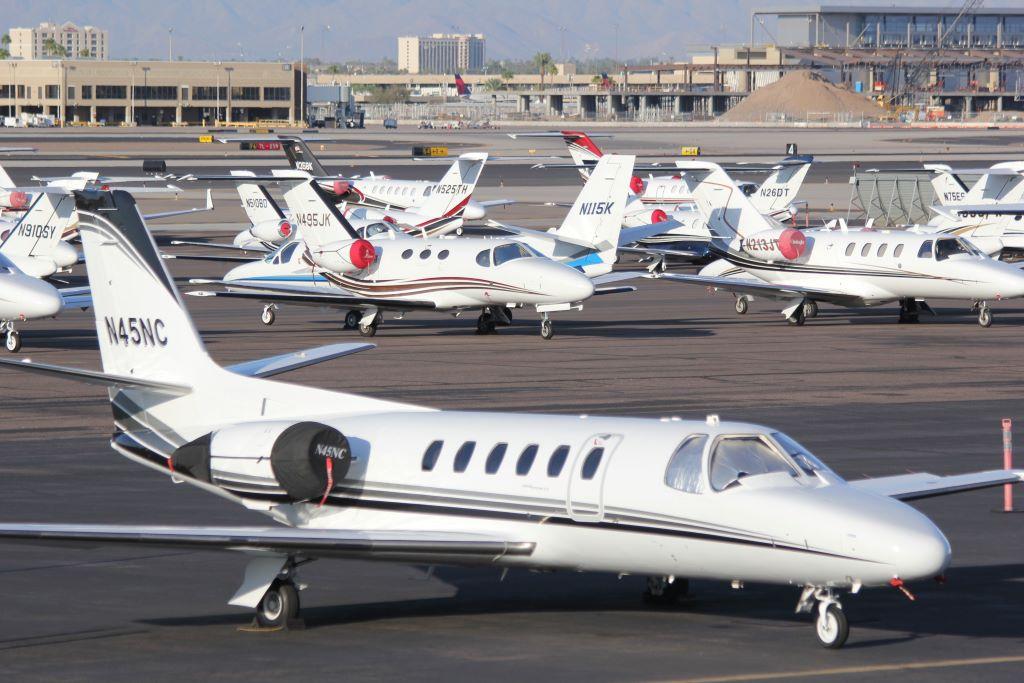Ramp Etiquette

An arriving Falcon is marshaled to the FBO’s number two spot, next to a King Air with both engines running. The trijet crew wisely makes the safe decision to delay opening their door, since the turboprop parked to their left would surely taxi momentarily.
With a ceremonial appearance of diligence and a near total lack of situational awareness, the Beechcraft pilots spend the next fifteen minutes holding the adjacent aircraft captive before finally getting underway. It is the longest fifteen minutes of the day for passengers on both airplanes. Pilots and passengers still in the lobby must also wait until the coast is clear, no doubt wishing the turboprop crew had taken their procedures to the runup area.
Suppose the newly arriving crew made a different decision and opened the airstair door once their engines spooled down. Deplaning passengers could then choose between walking behind the King Air, being blasted by cooked kerosene and prop wash, or passing in front of spinning propellers. Both alternatives feature avoidable risk, driven by the psychology of general frustration.
If this example were an isolated occurrence, perhaps the result of an aircraft system fault or other problem discovered after engine start, a delay is understandable. But variations of this story occur daily on FBO ramps, and frustrated observers are left wondering why the airplanes can’t seem to get moving.
A surge in demand for private air travel has created boom times for manufacturing, maintaining, training, and operating business aircraft. This has been particularly good news for aspiring professional pilots, and rapid advancement is commonplace.
Progressing from new hire to pilot-in-command might now be a matter of months rather than years. Without reasonable time in a structured environment with an experienced mentor, new pilots miss exposure to the subtleties of professional courtesy. And training organizations do not include ramp operations in the rigorous syllabus for type training and testing.
Needlessly incinerating jet fuel while on the ground makes a mockery of our industry’s effort to become more sustainable. And it makes sense to avoid ramp conflicts while reducing passenger and FBO employee exposure to obvious risks.
A readily available opportunity for improvement on both fronts lies in checklist design.
Taking shortcuts or skipping steps is not acceptable or suggested. Instead, take a hard look at your checklist organization, acknowledging that most are written by OEM attorneys who rarely optimize task flow for daily operations. These legacy tomes develop a life of their own because of reluctance to assume responsibility for changing the sequence of required tasks.
Consider checklist studies done by industry sources, add deep operational experience, and work to improve the document. Safety is enhanced when a checklist makes sense to the crew, rather than feeling like a top-down edict from a faceless source that does not routinely fly the airplane. For commercial operators, don’t hesitate to present a proposed revision to your Principal Operations Inspectors, especially if they have meaningful experience in type.
The Before Start checklist can be long, but the After Start/Before Taxi section should be short. Recording ATIS and your clearance should be accomplished well before engines are running. There likely are other items on your current After Start/Before Taxi litany that can be safely accomplished later without compromising runway incursion vigilance -- like on an uncrowded taxiway, penalty box, or runup area,
If a flight control check is accomplished before taxi, it can be invalidated by wind-driven debris, ice, or FOD encounters that happen during taxi to the runway.
Investigators opined that an unfortunate jet freighter mishap caused by a jammed elevator may have been avoided if flight control checks had been performed just prior to takeoff, rather than in the parking stand as directed by that operator’s checklist.
For our passengers, the flight begins when the door is closed and their confinement commences. They are traveling with you to save time, and should not be left wondering why the engines are whining but they’re not going anywhere. A useful benchmark is the typical airline flight, with movement beginning as soon as the tug is clear and engines are running. Once your engines are stable and running, please get off the ramp.
Ken Ambrose holds an ATP with more than a dozen type ratings ranging from light jets to 757-767. His business regularly consults on aviation management and airport real estate. www.ambrosecorporation.com




